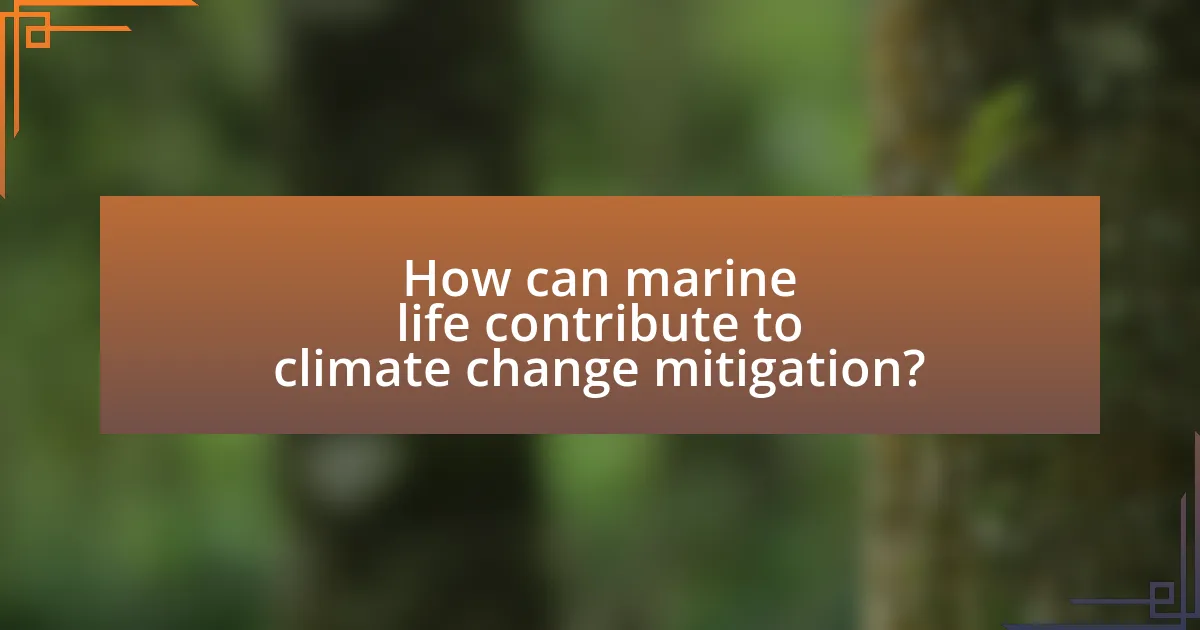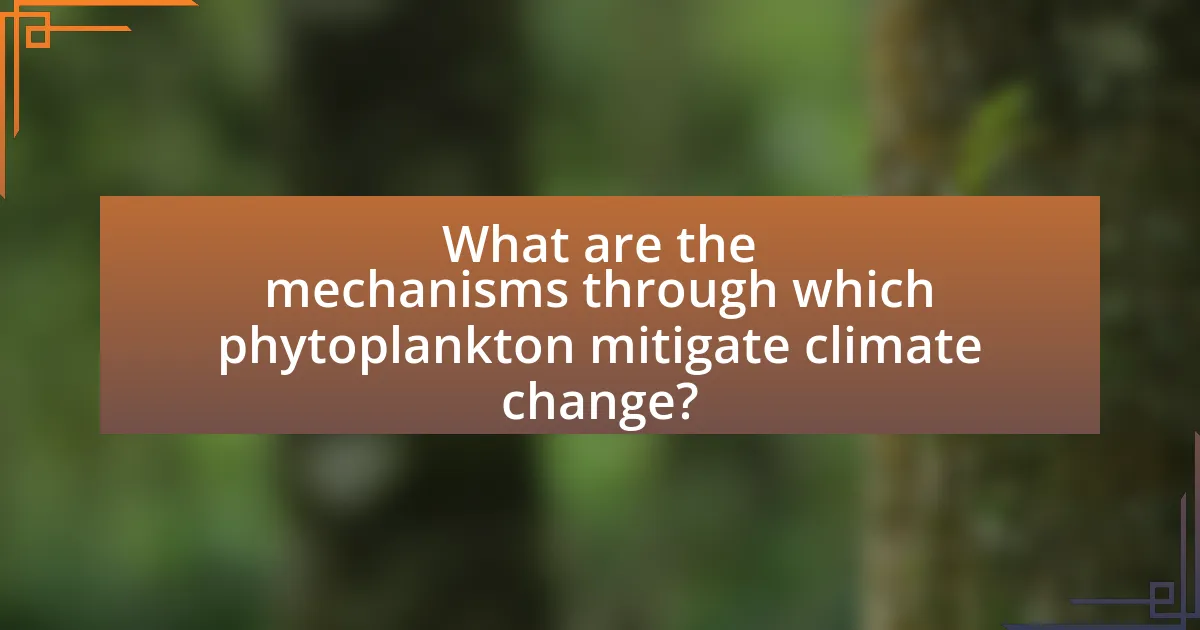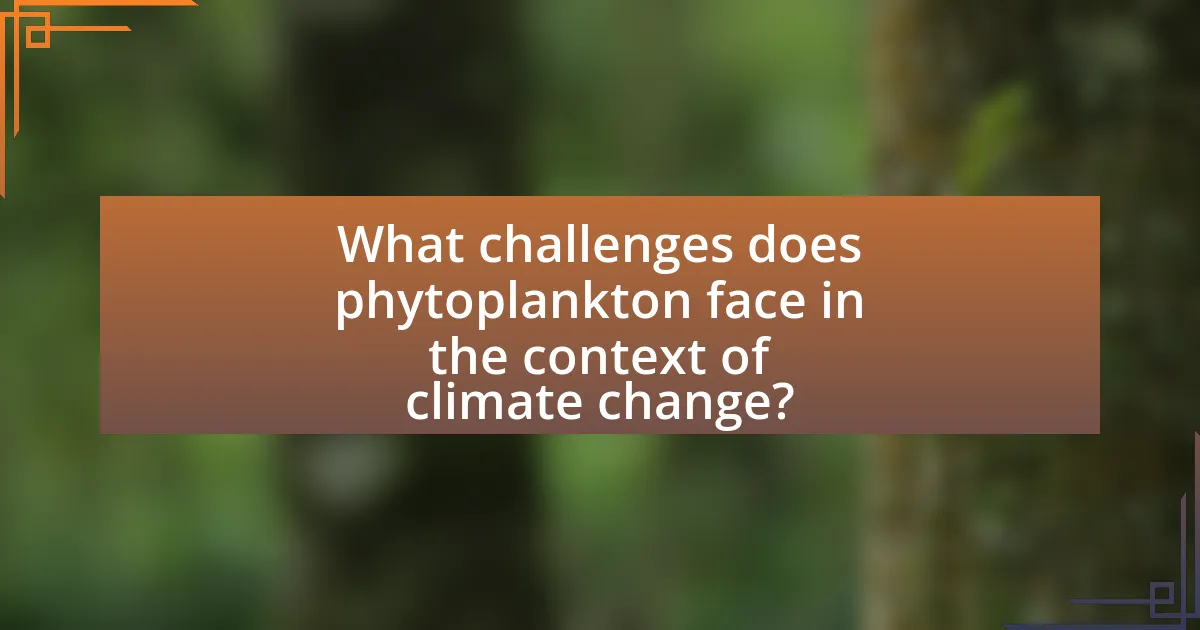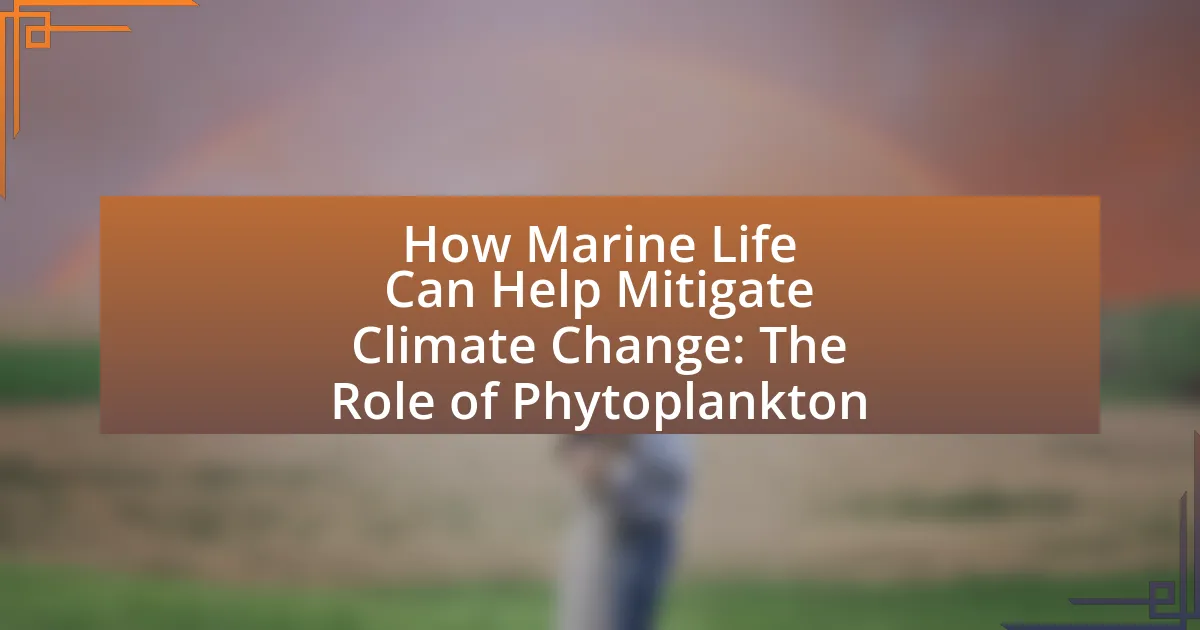Phytoplankton, microscopic marine plants, play a crucial role in mitigating climate change through carbon sequestration and oxygen production. They absorb carbon dioxide during photosynthesis, contributing to approximately 50% of the Earth’s oxygen and sequestering an estimated 1.8 billion metric tons of carbon annually. The article explores the various functions of phytoplankton within marine ecosystems, their impact on oceanic carbon cycles, and the challenges they face due to climate change, including rising temperatures and nutrient pollution. Additionally, it discusses conservation strategies and policy changes necessary to support phytoplankton health and enhance their ability to combat climate change.

How can marine life contribute to climate change mitigation?
Marine life contributes to climate change mitigation primarily through the process of carbon sequestration, particularly by phytoplankton. Phytoplankton, microscopic marine plants, absorb carbon dioxide during photosynthesis, converting it into organic matter and oxygen. This process not only reduces atmospheric CO2 levels but also supports the marine food web. According to a study published in the journal Nature, phytoplankton are responsible for approximately 50% of the Earth’s oxygen production and play a crucial role in the global carbon cycle by sequestering an estimated 1.8 billion metric tons of carbon annually. Thus, the health and abundance of marine life, especially phytoplankton, are vital for effective climate change mitigation.
What role does phytoplankton play in the marine ecosystem?
Phytoplankton serves as the foundational primary producers in the marine ecosystem, converting sunlight into energy through photosynthesis. This process not only generates approximately 50% of the Earth’s oxygen but also forms the base of the marine food web, supporting a diverse array of marine life, including fish, zooplankton, and larger predators. Furthermore, phytoplankton plays a critical role in carbon cycling; they absorb carbon dioxide from the atmosphere, helping to mitigate climate change by sequestering carbon in the ocean when they die and sink to the seabed. Studies indicate that phytoplankton productivity is closely linked to nutrient availability and environmental conditions, highlighting their sensitivity to climate change impacts.
How does phytoplankton photosynthesis impact carbon dioxide levels?
Phytoplankton photosynthesis significantly reduces carbon dioxide levels in the atmosphere. Through the process of photosynthesis, phytoplankton convert carbon dioxide into organic matter and oxygen, effectively sequestering carbon in the ocean. Research indicates that phytoplankton contribute to approximately 50% of the Earth’s oxygen production and play a crucial role in the global carbon cycle. For instance, a study published in the journal “Nature” by Behrenfeld et al. (2016) highlights that phytoplankton absorb around 30 gigatons of carbon dioxide annually, demonstrating their vital function in mitigating climate change by lowering atmospheric carbon dioxide concentrations.
What are the different types of phytoplankton and their functions?
Phytoplankton can be categorized into three main types: diatoms, dinoflagellates, and cyanobacteria, each serving crucial ecological functions. Diatoms, characterized by their silica cell walls, contribute significantly to primary production and carbon fixation, accounting for approximately 40% of the ocean’s photosynthetic activity. Dinoflagellates, known for their flagella, play a role in nutrient cycling and can form harmful algal blooms, impacting marine ecosystems. Cyanobacteria, the oldest photosynthetic organisms, are vital for nitrogen fixation, converting atmospheric nitrogen into forms usable by other marine life, thus enhancing nutrient availability in aquatic environments. These functions collectively support marine food webs and contribute to global carbon cycling, highlighting the importance of phytoplankton in mitigating climate change.
Why is phytoplankton considered a key player in climate regulation?
Phytoplankton is considered a key player in climate regulation because it plays a crucial role in carbon dioxide absorption and oxygen production. These microscopic organisms, through photosynthesis, absorb approximately 50% of the atmospheric carbon dioxide, significantly contributing to the global carbon cycle. Additionally, phytoplankton produces oxygen as a byproduct, which is essential for the survival of marine and terrestrial life. Studies indicate that phytoplankton blooms can sequester carbon in the deep ocean, effectively removing it from the atmosphere for long periods, thus helping to mitigate climate change.
How does phytoplankton influence oceanic carbon cycles?
Phytoplankton significantly influences oceanic carbon cycles by absorbing carbon dioxide during photosynthesis and contributing to the biological carbon pump. This process involves phytoplankton converting CO2 into organic matter, which then sinks to the ocean floor when these microorganisms die or are consumed by other marine organisms. Research indicates that phytoplankton are responsible for approximately 50% of global primary production, highlighting their critical role in sequestering carbon. Additionally, the export of organic carbon from the surface to deeper waters helps regulate atmospheric CO2 levels, thereby mitigating climate change.
What is the relationship between phytoplankton and marine food webs?
Phytoplankton serve as the foundational primary producers in marine food webs, converting sunlight and nutrients into organic matter through photosynthesis. This process supports a diverse array of marine organisms, as phytoplankton are consumed by zooplankton, which in turn are preyed upon by larger marine species such as fish and whales. Studies indicate that phytoplankton contribute to approximately 50% of the Earth’s oxygen production and play a crucial role in carbon cycling, thus influencing the overall health and stability of marine ecosystems. Their abundance and diversity directly affect the productivity and structure of marine food webs, highlighting their essential role in sustaining marine life.

What are the mechanisms through which phytoplankton mitigate climate change?
Phytoplankton mitigate climate change primarily through carbon sequestration and oxygen production. These microscopic organisms absorb carbon dioxide during photosynthesis, converting it into organic matter and oxygen. Specifically, phytoplankton account for approximately 50% of global oxygen production and play a crucial role in the ocean’s carbon cycle. When phytoplankton die, they sink to the ocean floor, effectively sequestering carbon for long periods, which reduces atmospheric CO2 levels. This process is supported by studies indicating that phytoplankton contribute to the biological pump, a mechanism that transports carbon from the surface to the deep ocean, thus helping to regulate the Earth’s climate.
How does phytoplankton contribute to carbon sequestration?
Phytoplankton contributes to carbon sequestration by absorbing carbon dioxide during photosynthesis and subsequently sinking to the ocean floor when they die. This process effectively removes carbon from the atmosphere and stores it in the deep ocean, where it can remain for centuries. Studies indicate that phytoplankton are responsible for approximately 50% of global primary production, highlighting their significant role in the carbon cycle. Additionally, the biological pump mechanism, where organic matter produced by phytoplankton is transported to deeper waters, further enhances carbon sequestration, making phytoplankton crucial in mitigating climate change.
What processes lead to the sinking of carbon-rich phytoplankton?
The sinking of carbon-rich phytoplankton is primarily driven by processes such as aggregation, sedimentation, and biological pump mechanisms. Aggregation occurs when phytoplankton clump together, increasing their size and density, which facilitates their descent through the water column. Sedimentation refers to the gravitational settling of these aggregated particles to the ocean floor. The biological pump mechanism involves the uptake of carbon dioxide by phytoplankton during photosynthesis, followed by the transfer of this carbon to deeper waters when they die and sink, effectively sequestering carbon in the ocean. These processes are critical in regulating carbon cycling and mitigating climate change by removing carbon from the atmosphere.
How does the ocean’s biological pump function in relation to phytoplankton?
The ocean’s biological pump functions by utilizing phytoplankton to convert carbon dioxide into organic matter through photosynthesis. Phytoplankton, as primary producers, absorb sunlight and nutrients, leading to the production of biomass. When these microorganisms die or are consumed, their organic matter sinks to deeper ocean layers, effectively sequestering carbon away from the atmosphere. This process is crucial for regulating global carbon cycles and mitigating climate change, as it removes significant amounts of CO2 from the surface waters and stores it in the ocean depths. Studies indicate that phytoplankton contribute to approximately 50% of the Earth’s oxygen production and play a vital role in the carbon cycle, highlighting their importance in the ocean’s biological pump.
What are the effects of phytoplankton on ocean acidity?
Phytoplankton significantly affects ocean acidity by absorbing carbon dioxide during photosynthesis, which reduces the concentration of CO2 in seawater. This process leads to a decrease in hydrogen ion concentration, thereby increasing pH levels and making the ocean less acidic. Studies indicate that phytoplankton contribute to approximately 50% of global primary production, playing a crucial role in the carbon cycle. As they photosynthesize, they utilize CO2, which mitigates ocean acidification, a critical issue exacerbated by increased atmospheric CO2 levels.
How does phytoplankton growth affect pH levels in marine environments?
Phytoplankton growth increases pH levels in marine environments through the process of photosynthesis, where they absorb carbon dioxide and release oxygen. This reduction in carbon dioxide concentration leads to a decrease in carbonic acid formation, which in turn raises the pH of the surrounding water. Studies have shown that during periods of high phytoplankton productivity, such as blooms, the local pH can rise significantly, enhancing the alkalinity of the water. For instance, research indicates that phytoplankton can elevate pH levels by as much as 0.5 units during blooms, demonstrating their crucial role in regulating ocean acidity and contributing to a more favorable environment for marine life.
What implications does ocean acidity have for climate change?
Ocean acidity significantly impacts climate change by affecting the ability of marine organisms, particularly phytoplankton, to perform photosynthesis and sequester carbon dioxide. Increased ocean acidity, primarily due to elevated carbon dioxide levels, reduces the availability of carbonate ions, which are essential for the formation of calcium carbonate structures in marine life. This disruption can lead to decreased phytoplankton productivity, which is crucial for carbon capture, as phytoplankton contribute to approximately 50% of the Earth’s oxygen and play a vital role in the global carbon cycle. Consequently, diminished phytoplankton populations can exacerbate climate change by reducing the ocean’s capacity to absorb atmospheric CO2, thereby increasing greenhouse gas concentrations and further warming the planet.

What challenges does phytoplankton face in the context of climate change?
Phytoplankton faces several challenges due to climate change, primarily including increased ocean temperatures, ocean acidification, and altered nutrient availability. Rising temperatures can lead to shifts in phytoplankton species composition, favoring those that thrive in warmer conditions while potentially reducing biodiversity. Ocean acidification, resulting from increased CO2 absorption, negatively impacts calcifying phytoplankton species, disrupting their growth and reproduction. Additionally, changes in nutrient availability, driven by altered ocean circulation patterns and freshwater influx from melting ice, can lead to nutrient imbalances, affecting phytoplankton productivity and the overall marine food web. These challenges threaten the ecological balance and the role of phytoplankton in carbon sequestration, which is crucial for mitigating climate change.
How do rising temperatures impact phytoplankton populations?
Rising temperatures negatively impact phytoplankton populations by altering their growth rates and distribution. Increased water temperatures can lead to thermal stratification in oceans, which reduces nutrient mixing and availability, ultimately hindering phytoplankton productivity. Studies indicate that warmer conditions can favor certain species over others, disrupting the balance of marine ecosystems. For instance, research published in “Nature Climate Change” by Thomas et al. (2017) shows that rising sea temperatures have led to shifts in phytoplankton community composition, with potential consequences for marine food webs and carbon cycling.
What are the consequences of nutrient pollution on phytoplankton health?
Nutrient pollution negatively impacts phytoplankton health by causing harmful algal blooms, which can lead to oxygen depletion and the production of toxins. These blooms occur when excess nutrients, particularly nitrogen and phosphorus, enter aquatic ecosystems, promoting rapid phytoplankton growth. Research indicates that such blooms can disrupt aquatic food webs, reduce biodiversity, and impair the ability of phytoplankton to perform photosynthesis effectively. For instance, a study published in the journal “Nature” by Anderson et al. (2019) highlights that nutrient enrichment can lead to shifts in phytoplankton community composition, favoring harmful species over beneficial ones, thereby compromising overall ecosystem health.
How does ocean stratification affect phytoplankton distribution?
Ocean stratification significantly affects phytoplankton distribution by creating distinct layers in the water column that influence light availability and nutrient access. In stratified oceans, warmer, less dense surface waters limit the mixing with deeper, nutrient-rich waters, leading to reduced nutrient availability for phytoplankton in the upper layers. This phenomenon can result in lower phytoplankton biomass and diversity in stratified regions compared to well-mixed areas. Studies have shown that during periods of strong stratification, such as in summer months, phytoplankton populations can decline due to nutrient depletion, impacting the entire marine food web and carbon cycling processes.
What role do human activities play in phytoplankton dynamics?
Human activities significantly influence phytoplankton dynamics through nutrient loading, pollution, and climate change. Agricultural runoff introduces excess nitrogen and phosphorus into marine ecosystems, leading to eutrophication, which can cause harmful algal blooms that disrupt phytoplankton communities. Additionally, industrial pollution and plastic waste can alter water quality and light penetration, further impacting phytoplankton growth and diversity. Climate change, driven by human emissions, affects ocean temperatures and stratification, which can shift phytoplankton distribution and productivity. Studies have shown that these anthropogenic factors can lead to declines in phytoplankton biomass and shifts in species composition, ultimately affecting marine food webs and carbon cycling.
How does overfishing influence phytoplankton communities?
Overfishing negatively influences phytoplankton communities by disrupting the marine food web and altering nutrient dynamics. When fish populations are depleted, the grazing pressure on zooplankton decreases, leading to an increase in their populations. This shift can result in higher competition for nutrients among phytoplankton species, potentially favoring harmful algal blooms over beneficial phytoplankton. Research indicates that overfishing can lead to changes in nutrient availability and light penetration, further impacting phytoplankton diversity and productivity. For instance, a study published in “Nature” by Worm et al. (2006) highlights that the decline of large fish species can lead to significant shifts in marine ecosystems, including phytoplankton communities.
What are the effects of climate change on phytoplankton biodiversity?
Climate change significantly impacts phytoplankton biodiversity by altering their distribution, composition, and productivity. Rising sea temperatures and changing nutrient availability can lead to shifts in species dominance, favoring certain phytoplankton groups over others. For instance, warmer waters may promote the growth of harmful algal blooms while reducing the diversity of beneficial species. Additionally, ocean acidification, a consequence of increased carbon dioxide levels, can affect phytoplankton’s ability to photosynthesize and reproduce, further threatening biodiversity. Studies have shown that these changes can disrupt marine food webs and biogeochemical cycles, highlighting the critical role of phytoplankton in ocean health and climate regulation.
What can be done to support phytoplankton in mitigating climate change?
To support phytoplankton in mitigating climate change, it is essential to reduce nutrient pollution and enhance ocean health. Nutrient pollution, primarily from agricultural runoff and wastewater, leads to harmful algal blooms that can deplete oxygen and harm phytoplankton populations. Implementing sustainable agricultural practices, such as precision farming and buffer zones, can minimize runoff. Additionally, protecting marine ecosystems, such as mangroves and seagrasses, supports phytoplankton by maintaining water quality and providing habitats. Research indicates that healthy phytoplankton populations are crucial for carbon sequestration, as they absorb approximately 50% of the Earth’s atmospheric carbon dioxide through photosynthesis.
What conservation strategies can enhance phytoplankton health?
Conservation strategies that can enhance phytoplankton health include reducing nutrient pollution, protecting marine habitats, and promoting sustainable fishing practices. Reducing nutrient pollution, particularly from agricultural runoff, minimizes harmful algal blooms that can deplete oxygen and block sunlight, which are detrimental to phytoplankton. Protecting marine habitats, such as coral reefs and mangroves, supports the overall health of marine ecosystems, providing a stable environment for phytoplankton to thrive. Additionally, promoting sustainable fishing practices helps maintain the balance of marine food webs, ensuring that phytoplankton populations are not adversely affected by overfishing or habitat destruction. These strategies are supported by research indicating that healthy phytoplankton populations are crucial for carbon sequestration and overall ocean health, which in turn mitigates climate change impacts.
How can policy changes promote the protection of marine ecosystems?
Policy changes can promote the protection of marine ecosystems by implementing regulations that limit pollution, establish marine protected areas, and enforce sustainable fishing practices. For instance, the establishment of marine protected areas has been shown to enhance biodiversity and ecosystem resilience, as evidenced by a study published in the journal “Nature” which found that such areas can lead to a 20-50% increase in fish populations. Additionally, regulations that reduce nutrient runoff from agriculture can mitigate harmful algal blooms, which threaten marine life and water quality. By prioritizing these policy changes, governments can create a framework that supports the health of marine ecosystems, ultimately contributing to climate change mitigation through the preservation of phytoplankton, which plays a crucial role in carbon sequestration.
